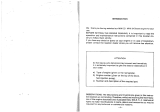
Maintenance Manual
This Owner’s Manual contains brief operating instructions
in the form of a maintenance schedule containing text and
illustrations
For the “Do-It-Yourselfer” we have put together a more
comprehensive Maintenance Manual which describes the
engine and its fuel, lubricating and cooling systems, etc. in
more detail. The Maintenance Manual also provides hints
on the tools you will need.
The Maintenance Manual can be bought from your VOLVO
PENTA retailer.
Safety
Preparations
We have put together the checklist below (to which you
can, of course, add your own notes) in order that you may
enjoy trouble-free running.
It is, of course, important that the engine, its equipment and
the boat in general are maintained according to the
instructions given in order to avoid breakdowns.
Travel plans
– Do you have a current nautical chart for the planned
voyage?
– Have you taken note of the weather forecast for the
area in which you will be travelling?
– Have you calculated the distance?
– Have you calculated the amount of fuel you will need?
– Where can you buy fuel on your journey?
– Do your relatives know of your travel plans?
The boat’s equipment
– Rescue equipment such as lifejackets and distress
rockets.
Does everyone on board know where they are?
– Spare parts on board, e.g. water pump wheel
(impeller) for the seawater pump.
– Tools which suit the equipment
– Full fire extinguishers.
The environment
We invest large amounts of money in ensuring that our
engines are as environmentally friendly as possible. We
hope, therefore, that you as a boat owner will continue to
help keep our environment clean.
As regards changes of oil and oil and/or fuel filters, it is
important that used oil or discarded filters do not make
their way into ordinary rubbish. Used filters always contain
a small amount of oil or fuel even when they have been
emptied.
Always hand in used filters and oil to a service or
environmental station which has special containers for
products which can be harmful to the environment.
Used batteries should also be handed in here.
AB VOLVO PENTA
Technical Information
Volvo Penta reserve the right to make changes
© AB VOLVO PENTA
Welcome on board!
You have chosen a boat with all the comfort you could ever
wish for, plus an engine with maximum safety which will be
extremely economical to run. We welcome you to our
worldwide service network.
Read this before you cast off from shore
We advise you to read through this Owner’s Manual even if
you are used to the sea and have previously piloted
various types of boat. Some things may be different to what
you are used to.
Warranties and Service
Provided with each engine is a description of the warranty
we issue for our product. The warranty card you receive
should be filled in and returned to VOLVO PENTA by your
sales representative: this is important both for us and for
you. Make sure this is done, because we may refuse to
undertake repairs on the warranty because the date of
delivery cannot be verified.
Some markets have other warranty conditions which
replace or supplement the VOLVO PENTA warranty.
Diesel fuel
Use “Autodiesel” diesel oil. An inferior fuel may cause
breakdowns.
Lubricating oils
Only use lubricating oils of the quality recommended in
“Technical Data”.
Maintenance
There are a number of maintenance instructions listed in
this Owner’s Manual. If these are not carried out in good
time, your engine may become less reliable and less
economical to run afterwards. Contact an authorised
VOLVO PENTA service workshop if you are unable to carry
out the prescribed maintenance yourself.
It is important that you always use original parts in order to
maintain VOLVO PENTA quality. It will be worth it in the
long run.
VOLVO PENTA has developed an extensive network of
retailers in order to be able to provide services and spare
parts.
Always state the complete type designation and serial
number when ordering spare parts
Safety instructions
When you see this symbol before an item of text, it
means that there is a danger of injury or damage
unless the instructions are followed.
7735333 - Downloaded from www.volvopenta.com 23/03/2014 10:16:13































